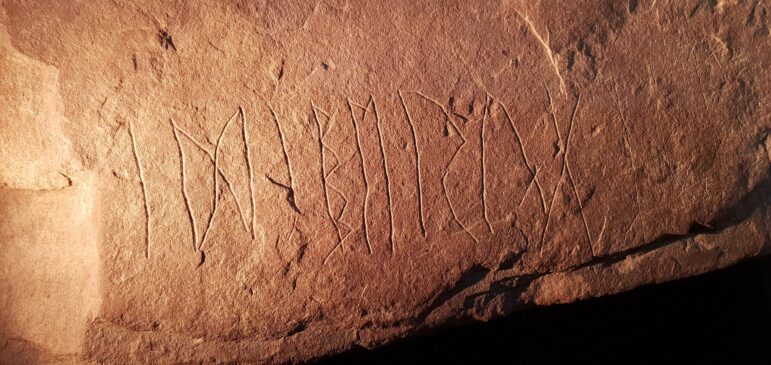LONDON – Recent research suggests that runic writing may have been used earlier than previously believed. A study published on February 3, 2025, in the journal Antiquity by researchers from the Museum of Cultural History at the University of Oslo, Norway, along with an independent scholar from Denmark, has revealed new evidence that challenges previous assumptions about the origins of the runic script.
Runes are commonly used in the Pagan and Heathen communities. As many know, they were the alphabetic script used by early Germanic peoples, but their exact origins and early use have been difficult to trace. Runestones, stones carved with runic inscriptions, are rarely found in their original locations and often lack clear dating.
Between 2021 and 2023, archaeologists from the Museum of Cultural History excavated the Svingerud grave field in Hole, Norway. They discovered a set of sandstone fragments bearing runes from the older futhark, the earliest known runic alphabet. Radiocarbon-dated artifacts found in the burial suggest that the grave belonged to the Roman Iron Age, dating between 50 B.C.E. and 275 C.E. Additional sandstone fragments with inscriptions were found in other locations within the excavation site.

Close-up of the idiberug/n inscription on the larger stone. Photo Credit: RexCrudelissimus [CC BY-SA 4.0
Detailed analysis confirmed that all the fragments were once part of a single standing stone, though they appear to have been inscribed at different times. Researchers suggest that the Svingerud Stone may have been deliberately broken apart to associate specific inscriptions with different graves. Now that the runestone fragments have been reassembled, the relationships between the various inscriptions provide valuable insights into the earliest forms of Germanic runes.
Many Viking Age runestones (from the late 10th and 11th centuries) contain phrases indicating they were raised in memory of deceased relatives. However, early runestones had more diverse functions and were used in different contexts. Researchers refer to the Svingerud fragments collectively as a runestone due to their inscriptions, though they acknowledge that they may have served multiple purposes over time.
Currently, about 50 stones with inscriptions in the older futhark have been dated to between the first and sixth centuries C.E. The practice of inscribing stones is believed to have begun around the fourth or fifth century C.E., though some stones may be from the second or third centuries. Establishing the age of runic inscriptions requires a combination of methods, including linguistic analysis, stylistic comparisons, and archaeological dating techniques such as radiocarbon dating and dendrochronology. Since runestones are rarely found in datable contexts, it has been difficult to determine when the first ones were created.
During the excavation, researchers identified several sandstone pieces scattered across three different graves, conveniently labeled Hole 1, Hole 2, and Hole 3. The primary runic fragment was found in Hole 2, while Hole 1 contained a larger slab, and Hole 3 had several additional fragments. When the pieces were assembled, they formed a single runestone, though some parts remain missing.
The inscriptions feature runes, along with other symbols such as triangular and zig-zag shapes. Some of the runic sequences are difficult to interpret due to damage and ambiguous markings, but researchers have identified several key inscriptions that provide clues to their meaning.
One inscription includes eight runes reading “idiberug,” which could represent a name, possibly of a deceased individual. Based on linguistic analysis, researchers believe this name might belong to a female. Another sequence contains the first three letters of the futhark alphabet (“f,” “u,” and “th”), which could indicate an early example of the futhark being written down. Another inscription found on the Hole 3 fragment contains the word “runo” (meaning “rune”) and the verb “fahido” (meaning “painted” or “inscribed”). Though some sections of the stone are too damaged to read clearly, these inscriptions suggest the stone played a role in early writing practices.
The presence of these inscriptions, along with various non-runic symbols, raises questions about the purpose of the Svingerud Stone. The engraver, some researchers suggest, may have been experimenting with writing, as runes were relatively new at the time. Others suggest that the inscriptions had symbolic or ritualistic meanings.
The use of runes may have been influenced by contact with the Roman Empire, as Latin writing was becoming more common in the region by the second century B.C.E. Additionally, some runes were associated with deities in Germanic traditions.

Over time, the runic alphabet evolved, reflecting linguistic changes from Proto-Norse to Old Norse in the 8th century. Runic writing continued to be used until the 14th century when Latin script became dominant due to the spread of Christianity. While the function of the Svingerud Stone remains uncertain, researchers believe it was likely created to commemorate the deceased. This aligns with later Viking Age traditions, where inscriptions commonly stated that “X raised this stone in memory of Y.”
Researchers note that the Svingerud find is therefore a major breakthrough in understanding the early use of runes on stone. It provides one of the few examples of an early runestone found in a well-documented and datable archaeological context. Though the time range is broad, this makes the Svingerud fragments the earliest known runestone. The unique inscriptions and symbols on the stone provide new information about early runic writing and challenge previous assumptions about the development of runestones in Scandinavia.
Furthermore, certain runes on the Svingerud Stone, such as a distinctive form of the letter “b” and the numerous zig-zag markings, suggest that early variants of runes were being tested or adapted for use on stone. The confirmed dating of the stone means that other early runestones may need to be reassessed in future research.
The study’s authors propose that the Svingerud Stone may have originally marked a single grave but was later broken into pieces and used for additional burials. Additional research is needed to determine the full purpose of the inscriptions and how they relate to early Scandinavian burial traditions. The stone is expected to undergo more detailed examination to uncover additional details about its inscriptions and the people who created them.
The Wild Hunt is not responsible for links to external content.
To join a conversation on this post:
Visit our The Wild Hunt subreddit! Point your favorite browser to https://www.reddit.com/r/The_Wild_Hunt_News/, then click “JOIN”. Make sure to click the bell, too, to be notified of new articles posted to our subreddit.
